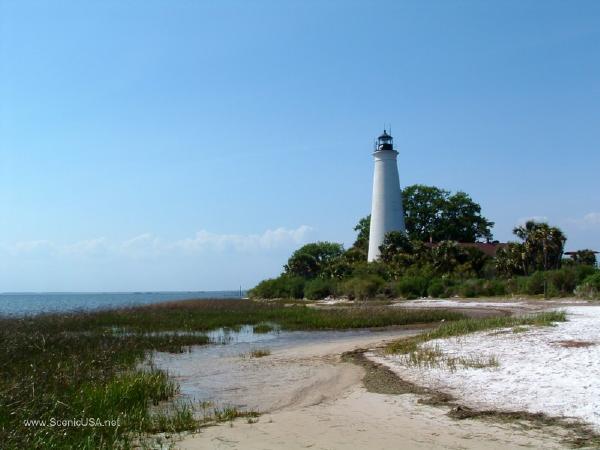St. Marks National Wildlife Refuge
The St. Marks National Wildlife Refuge covers an extended area of
70,000 acres, and 43 miles, of coastal
Florida from the Ochlockonee River to the Aucilla River - extending through
Wakulla, Jefferson and Taylor counties. Established in 1931 primarily to provide
wintering habitat for migratory birds, it is one of the oldest national wildlife
refuges in the country.

The visitor center, located about 25 miles south of Tallahassee, is the main visitor
focus for the refuge - although there are numerous other access points into more
remote areas. The visitor center area includes administrative offices, gift shop
and nature store, and an environmental eduction center. Drive about 7 miles
south to see the St. Marks lighthouse. Placed in service in 1831, it is the
oldest lighthouse on the Florida gulf coast.
Trail hiking is one of the most popular activities in the refuge. Trailheads for
two nature trails begin near the visitor center. The Stoney Bayou loop is 6.5
miles long, and the Deep Creek trail is a longer loop of 12 miles. Shorter
walking trails are also available at the visitor center and the lighthouse area.
A 49 mile segment of the Florida National Scenic Trail runs through the refuge
for those interested in backpacking.
Boating and kayaking in St. Marks National Wildlife Refuge is one of the key
attractions. There are at least a dozen boat ramps or kayak launch points
extending across the refuge offering access to the Gulf of Mexico, several of
the lakes within the refuge, and the seven rivers or streams that flow through
the refuge to the Gulf. The Florida Circumnavigational Saltwater Paddling Trail
extends along the coastal sections of the refuge - and primitive campsites are
provided for use by long-distance paddlers.
History buffs will also find interesting things to see and do within St. Marks
National Wildlife Refuge. In addition to the St. Marks Light - listed on the
National Register of Historic Places - check out the small town of St. Marks. It
was originally settled in the 1600's by the Spanish as the location of a port at
the junction of the Wakulla and St. Marks rivers for shipping cotton, A railroad
- some say it was Florida's first - connected St. Marks to the city of
Tallahassee. The site of the fort is now protected as part of the San Marcos de
Apalache Historic State Park.
Activities & Facilities
Museum or Visitor Center

Picnic shelter

Short hiking trails

Long hiking trails

Paved bike trails

Mountain bike trails

Open gulf kayaking

River or lake kayaking

Motor boating

Fishing